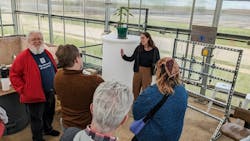MWRD, Northwestern University collaborate to remove wastewater contaminants
The Metropolitan Water Reclamation District of Greater Chicago (MWRD) is working with Northwestern University professors and graduate students to address trace organic contaminants in the wastewater at the O’Brien Water Reclamation Plant in Skokie, Illinois.
Trace organic contaminants pose a complex challenge to utilities like MWRD trying to detect and remove unwanted chemicals like drugs and per- and polyfluoroalkyl substances (PFAS).
Working with engineers from MWRD, AECON and Argonne National Laboratory, Northwestern chemistry and environmental engineering graduate students are working toward new discoveries.
The study stems from a U.S.-Israel consortium called the Collaborative Water-Energy Research Center (CoWERC), bringing together Northwestern and BGN Technologies, the technology transfer company of Israel’s Ben-Gurion University of the Negev (BGU). Together, they are developing modern technologies to solve global water challenges.
“We have been analyzing trace organics for decades long before they gained public attention, and we are taking many actions to address these contaminants through research partnerships like at our O’Brien Water Reclamation Plant,” said MWRD President Kari K. Steele. “We thank our partners at CoWERC and the many contributions and long hours spent by Northwestern University students and professors to unlock breakthrough technology to protect our water environment.”
Northwestern researchers have been using reclaimed water from MWRD for bench scale experiments in the lab but, as they scale up testing size, an increasing amount of water is required to determine the effectiveness of the study and how it can be implemented at a facility like O’Brien WRP.
“Not having access to safe drinking water is a massive problem facing society — both in Chicago and around the world,” said Aaron Packman, U.S. director of CoWERC and professor of civil and environmental engineering at Northwestern, where he directs the Center for Water Research. “Our water is particularly vulnerable to climate change and harmful contaminants like PFAS. Researchers at Northwestern, CoWERC and the MWRD are working synergistically to explore inexpensive, scalable solutions that will make our communities more resilient.”
Testing a contaminant treatment solution
Scientists and engineers are evaluating an apparatus that includes a series of columns with checkpoint valves monitoring water flow rates. Chlorinated water that has flowed through secondary treatment at the O’Brien WRP cycles into the columns where different adsorbents are tested for use as a polishing step in the later stages of the water reclamation process.
Researchers inject doses of trace organic contaminants and study how to best remove the contaminants using an adsorbent. The adsorbent, a novel beta-cyclodextrin based polymer developed by the Northwestern team, will attach to the contaminants and PFAS compounds and remove them from the water stream.
Beta-cyclodextrin is a bio-based renewable carbohydrate that is produced from corn starch and used in common household odor-eliminating products like Febreze. These polymers react quickly to adsorb more spontaneously and are selective for PFAS compared to conventional adsorbents. Researchers are seeing the effectiveness of the adsorbent, and are now assessing how long it lasts before the polymer becomes saturated with contaminants and releases contaminants in the water.
Many drinking water plants already use a similar type of system, employing granular activated carbon and ion exchange resins to remove metals and purify water. But researchers said these become quickly clogged by organic matter, making them less effective in removing trace organic contaminants in wastewater.
Unlike drinking water, researchers at the MWRD can take the wastewater from a treatment facility like O’Brien WRP, clean the water and treat it with adsorbents, and return an end product to the environment that is free of trace organics, allowing earth’s natural filter to take over, so the water can be used again in the future.
The research and development are impressive because, while new standards are applied to drinking water, the CoWERC collaboration is one step ahead by moving to address wastewater ahead of any new standards set by the U.S. EPA.
The Northwestern and MWRD scientists are not only developing a system of adsorbents to remove trace organics to keep unwanted chemicals out of the environment, but also assisting water scarce countries like Israel to apply and implement these practices in the future.
The goal is to assess the adsorbents at the O’Brien WRP on a smaller lab scale and gradually work toward larger applications to pilot after a year in the U.S. and Israel and then implementation if proven effective. Researchers will be collecting and testing treated wastewater exiting the facility using ultra-high performance liquid chromatography coupled with a mass spectrometer. The instrument can detect PFAS and other trace organic contaminants and better assess the adsorption capacity of the polymer and predict the treatment volumes and capabilities of a full-scale system.
“While we are not ready for full implementation, source control of chemicals is still paramount to removing them from the environment,” said MWRD Commissioner Eira Corral Sepulveda, “but partnerships like that of CoWERC are gradually showing how two different parts of the world are banding together and leading with ingenuity, promise, determination and hard work in the race to protect public health and the water environment from contaminants.”
